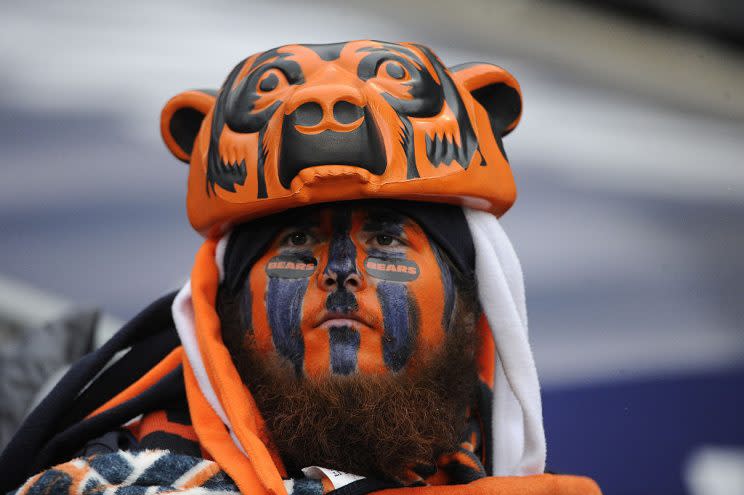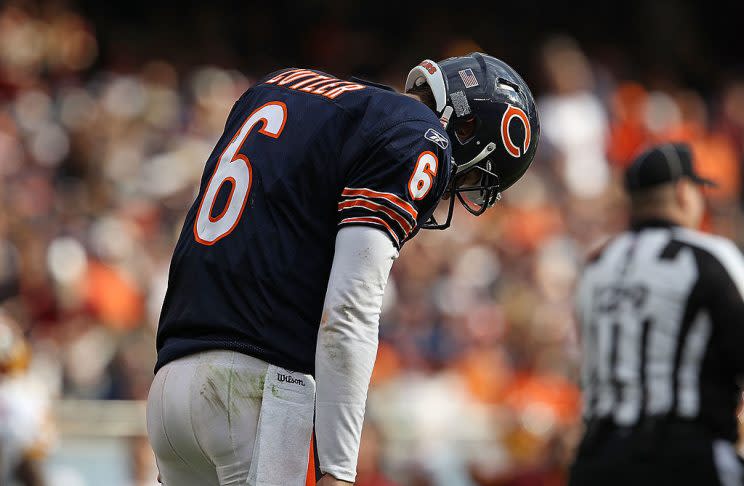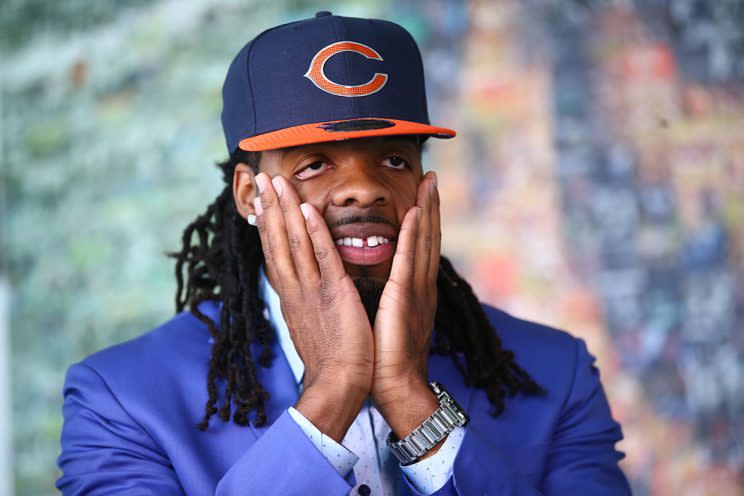Juggernaut Index, No. 24: The Chicago Bears

The Juggernaut Index is our annual ranking and review of NFL teams for fantasy purposes — repeat: FANTASY PURPOSES. Here, we concern ourselves with a franchise’s likely contributions to the fantasy player pool. We are not concerned with projected wins and losses. Instead, we’re focused on yards and points. As always, we’re beginning with the league’s least useful teams, working our way toward the elite fantasy juggernauts.
[Yahoo Fantasy Football is open for the 2016 season. Sign up now!]
The Chicago Bears are now entering the second season of a multi-year tear-down/rebuild under head coach John Fox and GM Ryan Pace, and the team spent its offseason improving the guts of the starting roster — pass rush, interior linebackers and O-line. Fox and Pace inherited an alarmingly untalented 53-man squad, so this was never going to be a quick turnaround. Realistically, the Bears need at least another year’s worth of roster enhancements and player development before it’s reasonable to expect them to challenge for anything meaningful.
But of course that doesn’t mean this team can’t still offer a little something to the fantasy community. However, Chicago’s offense doesn’t seem quite as appealing as it did last summer. Veteran multi-purpose back Matt Forte was allowed to leave via free agency and oddball tight end Martellus Bennett was traded to New England in March, so the Bears have shed talent at the skill spots. Jay Cutler is coming off his most efficient season as a pro (7.6 Y/A, 92.3 rating), but it was nowhere near his top fantasy performance (3659 yards, 21 TDs). And the architect of last year’s offense, Adam Gase, has departed for Miami, so Jay will be working with his sixth OC in eight seasons, which is less than ideal. Fortunately for Cutler, Gase has been replaced by last year’s quarterbacks coach, Dowell Loggains; it’s unlikely we’ll see radical scheme changes.
At this stage in Cutler’s career, it’s ridiculous to hope for anything better than last season’s level of performance — which, again, was very good by his standards. But fantasy owners need to realize that Chicago put the ball in the air only 523 times last year, the eighth lowest total in the league. Seven NFL teams attempted at least 100 more passes. Cutler will have a pair of 6-foot-3 rangy bookend receivers at his disposal — Alshon Jeffery and Kevin White — which should help him in no small way. He’s always been a see-it/throw-it passer, gifted with a massive arm, cursed with recklessness and stubbornness. Cutler is kinda like the Roy McAvoy of NFL quarterbacks. He’ll be directing another low-yield offense in 2016, so there’s no reason to draft him in, say, an 8 or 10-team league. Last year, he was the No. 20 fantasy scorer at his position; it’s awfully tough to see a path to a top-12 finish in 2016.

Jefferey has exceptional go-get-it ability and he has two 1000-yard, 80-catch seasons to his credit. He was a significant disappointment last year (54-807-4), though, as he struggled with a medley of nagging injuries. Still, his upside has been established at something like 90-1400-10, so we need to continue drafting Jefferey as a top-10-ish receiver in any format. When Cutler gets radar-lock on a player, that guy generally becomes a fantasy monster. So it was last year with tight end Zach Miller, Bennett’s replacement, who delivered a terrific second-half in 2015, snagging 29 passes for 381 yards and four spikes. Health has been the issue for Miller historically, but his play was of the highest quality last year, complete with highlight grabs. If you miss on the top-three tight ends at the draft table, it’s completely reasonable to take an end-game flier on Miller. He’s well-positioned for a big season if he can remain upright and healthy — think Kelce’s numbers, without the sixth-round price tag.
Second-year receiver Kevin White is really more of a first-year receiver, because he spent the 2015 season recovering from a stress fracture in his left shin. White was the seventh overall pick in last year’s draft, coming off a beastly campaign at West Virginia (109-1447-10). He blends excellent size and strength with silly speed (4.35), so he definitely looks the part of a No. 1 receiver. Of course he won’t be asked to actually dominate targets for this team, not while Jefferey and Miller are properly functioning. White’s upside is at least as high as any receiver in the current rookie class (Doctson, Coleman, Treadwell, et al), and he’s healthy at the moment. He’s a nice risk/reward bet in our game and he carries a friendly ADP (81.8).

IMPORTANT: Do not mess with any members of this team’s receiving corps, unless they were mentioned above. Do. Not. Do it. We shall speak no more of them.
Chicago’s backfield has the look of a dreadful committee with Jeremy Langford as its head. Langford was adequate if not special last season, running as a rotational back behind Forte. He made a few wow-plays in a mid-season win over the Rams, gaining 182 scrimmage yards on 27 touches, but he ultimately finished his rookie year averaging only 3.6 YPC. Our friends at Pro Football Focus have treated Langford like a piñata, because … well, because he’s not unusually skilled at avoiding tackles or catching footballs. These are legit concerns. And even if Langford had shown us more as a rookie, we would still have to acknowledge Coach Fox’s deep history of RBBC arrangements. The bottom line here is that you can’t draft Langford expecting him to give you more than 12-15 touches per week.
Backup running back Ka’Deem Carey is another ordinary-ish talent by NFL standards (3.7 YPC), and it’s worth noting that he was drafted by a prior front office administration. He’s probably not the handcuff you’re looking for. Rookie fifth-rounder Jordan Howard is much more interesting to me, because the price is dirt-cheap (ADP 152.8) and he delivered back-to-back productive seasons at the collegiate level at two different schools, in two different systems. He’s a big back (6-foot-0, 230) with power and a seemingly innate feel for finding running lanes. Howard is a substance-over-sizzle sort of runner (highlights here) with a path to a substantial role in year one, which makes him a nice end-game target.
Chicago’s defense was a major offseason focus, and the unit is undeniably improved. The team added linebackers Danny Trevathan and Jerrell Freeman in free agency, then traded up in the first round of the draft to snag edge rusher Leonard Floyd. These are nice enhancements, certainly. But it’s not as if the Bears D was anywhere close to achieving fantasy relevance last season. This group allowed 24.8 points per game, ranked No. 22 against the run (120.8 YPG, 4.5 YPC), and intercepted only eight passes. Chicago might be a reasonable choice for D/ST streamers in Week 2 (vs. Phi), but there’s no reason to draft this bunch in any format.
—
2015 Offensive Stats & Ranks
Points per game – 20.9 (23)
Pass YPG – 228.8 (23)
Rush YPG – 115.9 (11)
Yards per play – 5.4 (19)
Plays per game – 64.0 (18)
—
Previous Juggernaut Index entries: 32) Cleveland, 31) San Francisco, 30) Philadelphia, 29) Baltimore, 28) Tennessee, 27) Los Angeles, 26) Miami, 25) Detroit, 24) Chicago

 Yahoo Sports
Yahoo Sports 

